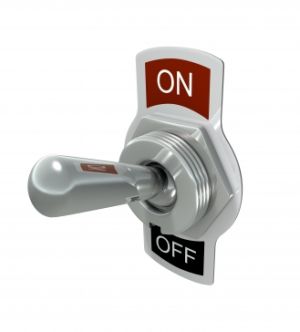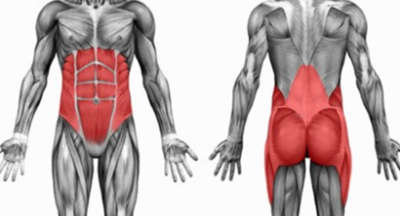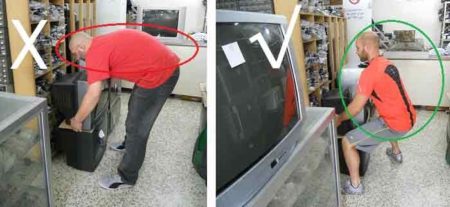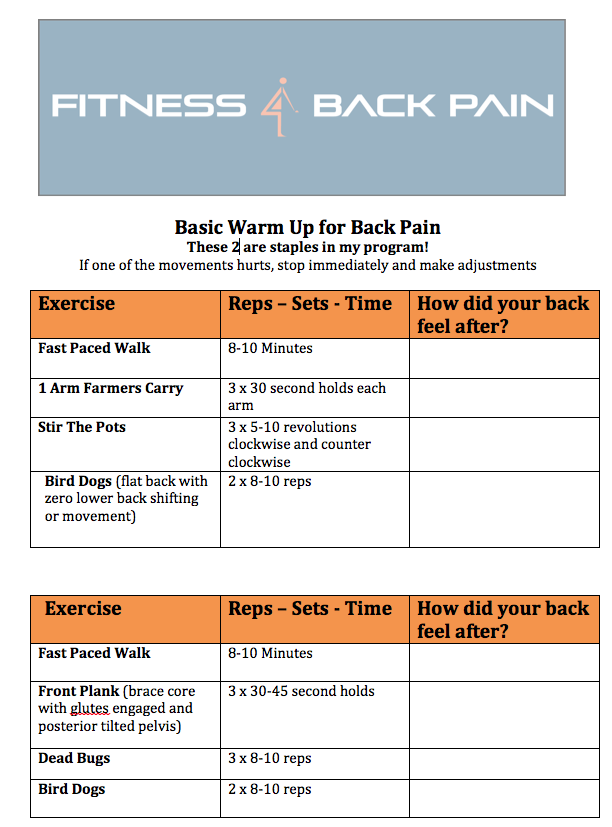Working out with back pain can be brutal. One day it seems to relieve your pain and the next day your laid up in bed on as much Ibuprofen and Tylenol as Google.com says is safe to take. The fact of the matter is if you’re constantly battling back pain in the gym you need to take a step back and reevaluate what your doing, how your doing and whether or not the gym is best place for you to be trying to heal
Today i’ll be specifically speaking to anyone who can relate:
-Your back pain is inconsistent. Some days it’s on and some days it’s off.
-You have back pain but not sure what steps to take to using exercises as a means of relief.
-You think muscle weakness is whats causing your back pain.
-You check your form and it looks good but your back still hurts.
-You only workout because your doctor says it will help with your pain…well, its not helping.
So you think working out is the best thing for your back huh? I wish it was that easy. That’s coming from someone who owns a site called Fitness 4 Back Pain! To be honest working out with back pain is one of the most common issues most people deal with in the gym. They either come into the gym with a little pain and leave with no back pain at all or they come in with no back pain at all and leave with a lot. Either way there is a reason your dealing with back pain and odds are it’s in the details of your workout.
My goal for you with this post is not only optimize your workout to be the most pain free experience possible but empower you to find relief for yourself. For this, sometimes using a reputable supplement such as the Focus pills from AddieUP can aid you extremely well by increasing your mental energy – allowing you to focus on the workout at hand, rather than any back pain you may have. Exercising with back pain is not just about avoiding certain exercises and reducing certain activities but bringing awareness to things that even the best coaches and trainers either don’t pick up on or don’t have the experience to really address.
This article contains affiliate links to products that I personally approve of!
Here are 10 of the most critical mistakes your making when it comes to working out and dealing with back pain.

1 – Not really understanding your pain triggers:
Listen up
Before you go and do any stretching, strengthening, yoga, body pump or cryo-therapy, please take minute to develop this very important list. Gone are the days where you just walk into a gym and move stuff around thinking “exercise is good for me”. All that goes out the window if you’re one of the lucky ones with back pain. One of the first things you need to do is create some kind of pain journal or pain trigger list. I know that sounds like a terrible thing to do but it’s essential to learning the limitations you will have when exercising. It’s pretty easy, make a note on your workout log about your back and how it felt going into the workout, during the workout, after specific exercises and even days after. The sharpest tool in your shed will be how well you know what positions, moves and exercises cause pain and what brings relief. Armed with this information it can make working out with back pain a thing of the past.
2 – Train your core FIRST:
For years I preached the opposite to all of my clients. My reasoning was that it wasn’t smart to weaken the core muscles before using them for bigger lifts where you would need them fully primed and not pre-fatigued. I can respect this thought still but when it comes to dealing with back pain you have to think the opposite. The average gym goer isn’t trying to compete in their local power lifting competition or break any records. You want to have fun, feel better but ultimately be pain free. You want to be safe but whats important now is how well your lower back is protected while you exercise. The root cause to back pain can very but a lot of back pain cases deal with instability in the spine combined with poor movement. If you’re working out with back pain, start each workout off with some basic core stiffening exercises. Below are three of my staple exercises I use in my own workouts.
1 – 1 Arm Farmers Carry
2 – High Low Chops
3 -Stir The Pots
3 – Too Much Pelvic Tilt
Yup, made this mistake for over 10 years before realizing what I was doing wrong. There is a difference between a flat back and locking out in over extension. Sure, I can lock my back in a “supported” position before squatting or dead-lifting but if that position consists of loading the facet joints going up and down your spine guess what…your backs going to hurt. This is easily one of the biggest mistakes most people in the gym are making when it comes to working out with back pain. This “chest out butt out” approach may have worked when you were younger but now the cumulative affects of these poor mechanics are driving the boat that is your chronic back pain. Don’t allow extension to be your default “braced position”. Learn how to open your hips, stack your body well and hip hinge with a stable flat back!
4 – Too much shearing going on.
You’re guaranteed to workout with constant back pain if you don’t learn to look for this issue. I’m talking to those who don’t really understand proper bracing or have instability in their lower back and spine. When you go to do bent over rows with that bar or dumbbell, there is a shearing force going on in your lower back. When you squat with that weight on your back or out front, there is a shearing force in your lower back. When you lunge, dead-lift, shoulder press or pull any kind of weight there is a shearing affect.
Your first goal is to reduce the inflammation and irritation you have but in the mean time, you can do more supported exercises to take some of the pressure off of your back. What I mean by “supported” is you’re performing the same exercises but instead of using your own ability to brace, you’re putting something between you and the weight you’re lifting that acts as your support. This support whether it is a stability ball or bench won’t move thus giving you the support you need to keep the back neutral through out the whole lift.
A great example of this is switching unsupported bent over rows with supported ones.

5 – Too much bracing or not enough.
Did you know that if you’re currently working out with back pain and have either facet joint injuries or disc issues, bracing your core can actually add compression to the area and make your pain worse? Yup, made that mistake for a couple years myself. Followed what the “pro’s” vaguely suggested for a while before having my own “aha” moment when I learned how sensitive an irritated disc can be. Even your core bracing has to be dialed in to fit your specific pain level.
You can practice this at home. Before bending to spit the toothpaste out of your mouth or pick up and basket of laundry. Play around with how hard you brace your core. You don’t want to brace while lifting a basket the same way you brace to squat, dead-lift or any other heavy lifting. Each activity requires a different level of bracing. There is no other way of learning what works for you other then doing it yourself. Experiment with different levels of bracing intensity with a proper HIP HINGE while doing different tasks. This will help you keep from making things worse without even knowing it.

6 – Exercise isn’t for you.
If you’re working out with any level of back pain you must ask yourself this question.
Is me being at the gym making things better or worse?
I passionately believe you can heal years and years of chronic back pain in the comfort of your own home. For some, basic movement corrections and habit building is all they need in order to see relief. This process can take months and for some, years to see a full recovery but it’s very do-able. When it comes to exercise, it’s never one of those “work through the pain” kind of situations. The exercises you perform should be limited to those that either BRING relief or FIX an imbalance to ultimately see relief. If you’re working out with back pain thinking that just by being active your pain will go away, you’re very wrong. You have to be intentional about how you workout. If you leave the gym with a little back ache or experience back ache for days after, really consider reevaluating not only what you’re doing in the gym but if “gym time” should even be in your rehab program.
3 Reasons why someone with back pain should be in the gym
-
You have been able to establish a healthy list of pain triggers and you know exactly what to do to keep your pain from flaring up.
-
You are in phase 2 of my coaching program and are introducing dynamic movements and core development without any sever pain.
-
You have successfully rehabbed your back from home and are wanting to introduce more load to your exercises to challenge your bracing and muscle endurance/strength.

7 – Not all exercise is created equal: The P90X Affect
If you’re convinced that your exercise program should consist of actually “working out”, rethink the type of exercise you’re using. I’ll tell you right now, the more dynamic movements like jumping, twisting and bouncing around you’re doing, the longer your pain med prescription will need to be filled. I am not 100% against working out with back pain but you have to do it right. I see so many people complain of how their back hurts yet they brag about how hard Tony Hortons latest workout program is. Instability in your spine and cumulative affects of poor movement put you in this position in the first place. In order to reduce the inflammation in your lower back you have to keep the movements controlled without any sudden twisting or rough impact. If you’re in the early phases of your rehab program, getting in a “good workout” shouldn’t even be on your mind. Once you build a more resilient back you will be able to introduce more of this back in but for now make good choices.

8 – You only protect your back 50% of the time.
I was one of the most attention to detail lifters growing up. I was always looking for good form and practiced it the best that I could while lifting. The problem I had was abandoning this relentlessness for good form once I left the gym. The minute I walked out of the gym all of that attention to detailed left. The people without back pain have it easy. How they move really isn’t on the front of their mind. It’s hard to remind yourself of these movement fundamentals. Unfortunately, if you’re reading this, your back is already hurt and this attention to detail is a must if you ever want to fix your back. I can’t stress this enough, the only way you will get off this pain cycle is by addressing ALL movement issue both in the gym and outside of the gym. If you don’t think the way you do mundane activities and movements through out the day is directly connected to the past 5+ years you have been dealing with back pain, you have A LOT to learn.
4 Common habits you do after a workout that affects your pain level.
1 – Washing your lower body in the shower. I trust that most people just carelessly bend over to wash their legs. Either bringing your leg up higher so that you don’t have to bend over or you hip hinge and keep a flat back while you reach down.
2 – Putting on your clothes. Sit down to put your pants on, don’t carelessly bend over losing all stability in your lower back.
3 – Tying your shoes. Don’t bend over to tie your shoes. Bring them up on top of a high bench and hinge at your waist to bend over to tie them. Either that or take a knee to bring yourself down to a lower level so that you can keep a stable back.
4 – Carelessly bending over to pick up your towel, old clothes and gym bag before heading to your car to sit for the next 30 minutes. Hip hinge, hip hinge and more hip hinge.
9 – Transitional Back Pain Triggers.
If you’re exercising with back pain, pay close attention to what you do and how you move between sets and exercises. You may have just completed a perfect set with stellar form but now your form is gone as you repeatedly bend over to un-rack the plates and put them away. This transition from performing the exercises with good form and now bending to lift the plates OUT of good form, is a guaranteed way to injure your back or stay injured for that matter. This is an even more common issue when dealing with dumbbells. Be mindful of your position at all times. The set or rep may be over but your back is still susceptible to stress.
Check out how I handle these transitional situations in this video!
10 – Your Warm up sucks
My warm up is a high priority to me when it comes to keeping off any kind of pain cycle. Even if I am short on time, I will work some kind of warm up into my program. Jumping on a treadmill and busting out a fast paced 2 mile run and getting right into your workout isn’t the most ideal. You want to get the trunk engaged and firing before getting into your workout. We talk about training core first but now lets talk about what you do before you even do that. Creating stiffness in your core not only feels great going into a workout but it protects you from micro movements that may trigger a flair up. Getting the trunk firing properly is like having a lifting belt cinched around your belly while you walk around the gym. It’s added insurance. Basic bracing techniques need to be applied while actually doing the lift but during those transition and subconscious movements this really helps in protecting your back.
My typical warm up looks something like this
Check out the free PDF of my go-to warm ups!
Find a way to constantly be reminded of these 10 things. The more you see it the more you will be able to trigger new thought process and beat old habits. Beating back pain is just as much habit creation as it is learning specific stretches and exercises. You have to address the entire package! Combine this with these 25 bad habits and you will be well on your way to exercising pain free!!
Talk to you guys soon!
William



2 thoughts on “10 Critical exercise mistakes that are causing you back pain”
Comments are closed.